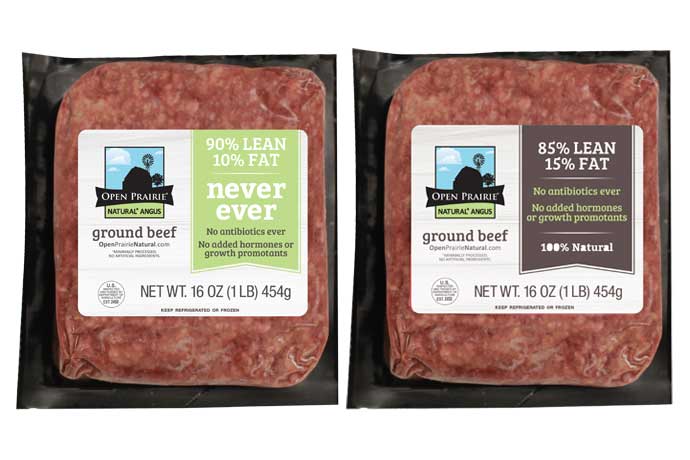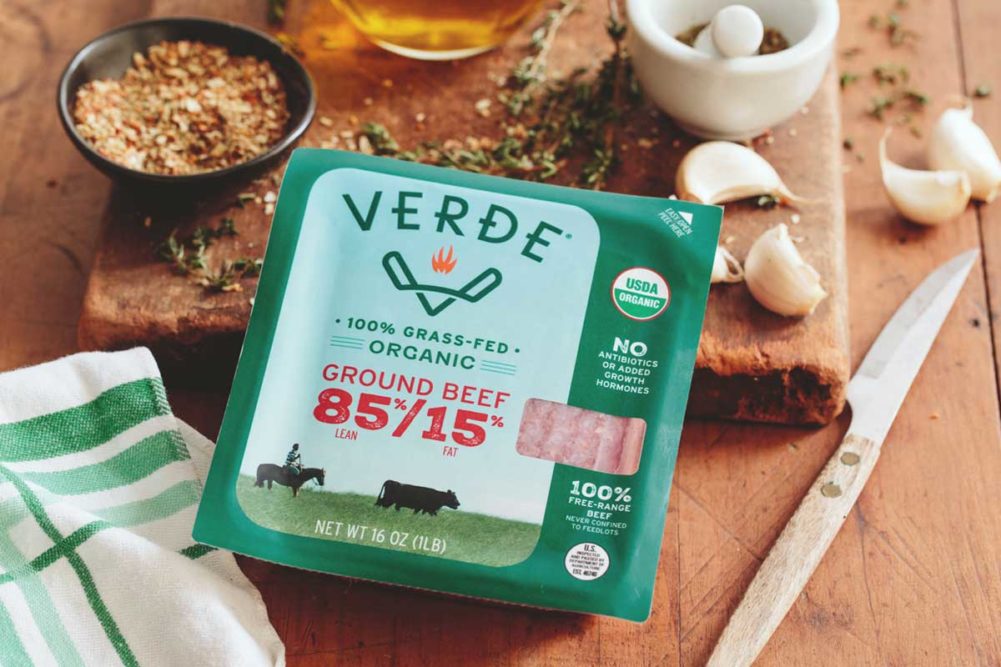Ground beef processors and their customers have the same goal when it comes to packaging: attract consumers to their products. Once companies figure out what customers, and ultimately consumers, want and are drawn to, they can design and configure packaging to accommodate. But it’s a fine line trying to appease a broad base of customers and shoppers while keeping costs in check.
Processor perspective
Tyson Fresh Meats Inc., Dakota Dunes, SD, did a retail packaging study approximately 18 months ago for its portioned proteins innovation team. The study concluded practicality as a top priority among consumers when it came to meat packaging in general. They preferred features such as easy to open, easy to reseal, easy to store, etc.
“When asked specifically about ground beef, overwrap packaging was still the most commonly purchased, followed by modified atmosphere packaging (MAP) and chub,” said Kent Harrison, vice president, marketing and premium programs, Tyson Fresh Meats. “We see a major opportunity for brick packaging, as it is quite appealing to consumers, but had the lowest awareness in the group we polled.”
Boston-based Verde Farms uses vacuum-packed brick packaging on its top-selling 100% grass-fed, 100% pasture-raised organic ground beef. However, the company believes its “registered” film differentiates it from the competition.
Vacuum-sealed brick packaging typically uses a non-forming film for the back of the package and a forming film for the front. Printed labels are then adhered to both sides. Verde rolled out its “registered” version of this in mid-March and eliminated the need for labeling on both sides.
The term registered means the image used as the label is printed on the non-forming film which becomes the front of the package. The printed design also contains a small white box the packaging line uses to register the position to perfectly align the image on the product.
“By using registered film, we’re able to flip the typical process on its head to provide a much higher quality visual image and enhanced branding,” said Pete Lewis, vice president of marketing at Verde. “We do this by literally flipping the product orientation: what is typically the back of the product becomes the front. Instead of applying a label, we now print an image directly onto the non-forming film. This gives us a much larger primary display panel – 230% larger in fact – that allows our brand to stand out and clearly communicate our key attributes at the shelf. Printing on film also allows for a high-quality image that is more durable in cold and damp conditions in the refrigerated supply chain. It has also allowed us to create a transparent ‘window’ for the consumer to see the product without picking it up.”
Lewis expanded on packaging’s crucial role in overall product value.
“We knew using registered film would provide differentiation from competitors, spotlight Verde’s attributes on the shelf, and enhance our brand image,” he said. “For many brands, especially premium, packaging is one of the best marketing tools. Most consumers will become aware of brands at the shelf, so first impressions are critical.”
Verde knew it would change to registered packaging for its new plant that opened August of 2019 in Mullica Hill, NJ. As the new plant has grown into its capacity and capabilities, Verde has consolidated its processing there from co-manufacturing partners.
“Launch of the film was originally planned for Fall 2020, but the pandemic threw us some curveballs on timing,” Lewis said. “We had to make some minor modifications to our code date printers and labeling machines to work with the new format, but these weren’t difficult to execute, and the process is running smoothly as a result of our trials.”
Tyson Fresh Meats understands the important role packaging plays in marketing and as the primary method brands use to communicate with consumers. Because of the way packaging influences shoppers, the company continually evaluates and adjusts its packaging accordingly. A recent change in ground beef specifically has been a complete revamp of ground beef chub design, spanning lean points, primal types and weights.
“Packaging plays an essential role in the shopping experience,” Harrison said “Research shows that if a consumer touches a package, they buy it more than 80% of the time. This is why packaging is such a priority to us, because we think of it as the way our product is brought to life.”
Tyson’s use of research and consumer surveys represents an all-encompassing and ever-evolving strategy for its decisions regarding packaging. Especially with the “new normal” of today’s overall food experience, buying habits and preferences can quickly change.
“Gauging consumers’ priorities can be tricky when designing packaging for ground beef products,” Harrison added. “For example, the group we surveyed indicated that factors like freshness and the environment were important to them, but when it comes to choosing a ground beef package, most were more likely to select a traditional overwrap package instead of a more modern package that addressed those needs and cost more. We also did significant work revamping our chub packaging to appeal more to consumers, and we’re proud of those changes.”
Applications
 Source: Tyson Foods Inc.
Source: Tyson Foods Inc.
Tyson Fresh Meats serves different channels and offers different brands. The packaging it chooses for the different ground beef products it offers depends on the channel and brand. The company will package ground beef in chub, overwrap, MAP and brick formats, depending on the situation. As always, Tyson studies how to make adjustments and improve the packaging options according to preference.
“When we developed a chub packaging test specifically in the summer of 2019, we found that paying close attention to design can elevate the perception of chub packaging,” Harrison said. “For example, consumers vastly preferred a transparent window in their chub packaging so they could see the meat they were buying. We also found that prominently displaying the lean points in a large, easy-to-read font on the package helped consumers make a selection quickly, alleviating a small inconvenience for them when shopping.”
Tyson cites factors like easy storage, leakproof packaging, clear labeling and callouts to make packaging practical and convenient, a top priority for all involved.
“Also, it’s extremely important to us to offer extended shelf-life opportunities with packaging innovations while still ensuring an attractive merchandising option for consumers,” Harrison added. “For retailers, having more shelf life for their ground beef category creates enormous efficiencies and margin opportunities.”
Verde believes its new registered packaging provides its products “jump-off-the-shelf visual differentiation” from its competitors and fulfills consumer expectations for premium priced offerings.
“Interestingly, this enhanced packaging comes with little added cost,” Lewis said. “The printed film is more expensive than commodity film, but it allows us to eliminate one of two labels. More importantly, it allows a notable increase in throughput because the label we’re eliminating is somewhat tricky to land squarely on the brick of ground beef. This caused some push-pull between the operations and marketing teams – throughput and having a great looking label are both important. With registered film, our line speed increases.”
Regardless of the attributes packaging tries to convey or provide, or the margins and value it supplies, a solid yet flexible strategy provides processors the marketing and customer service tools to showcase their ground beef products.



